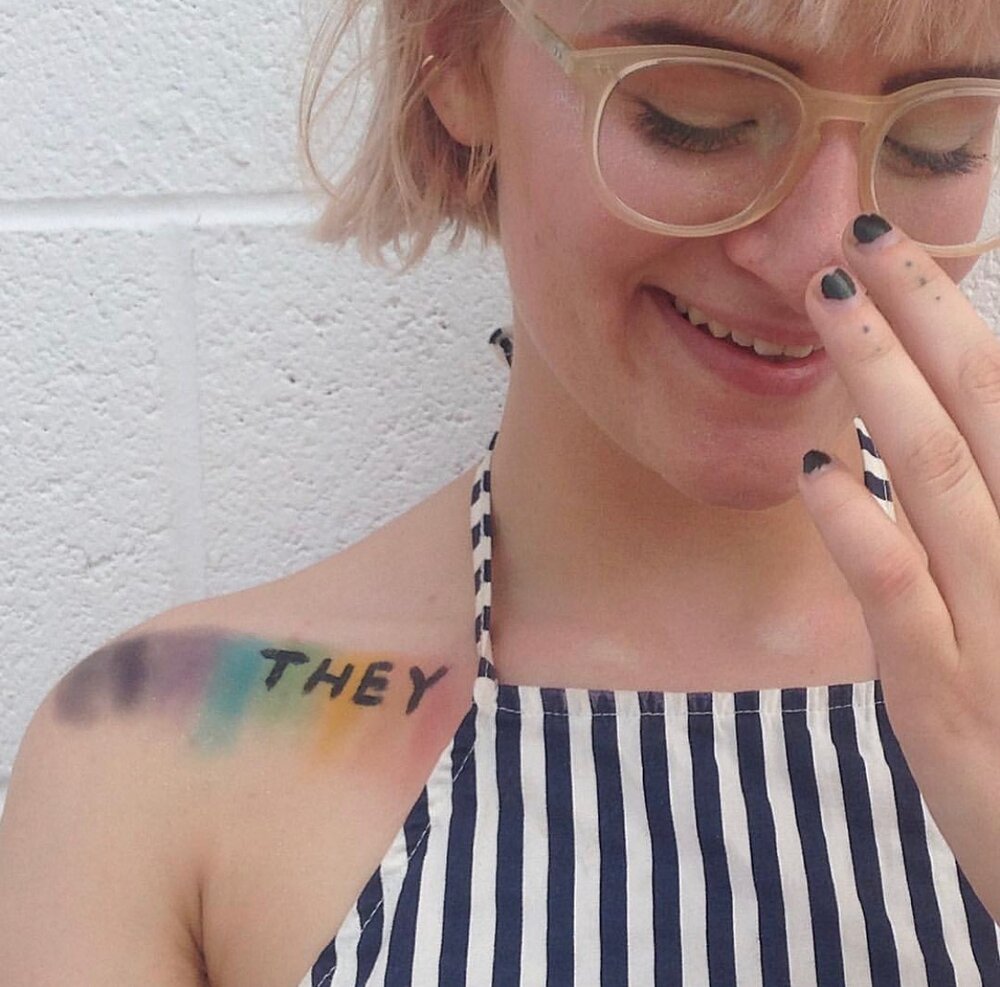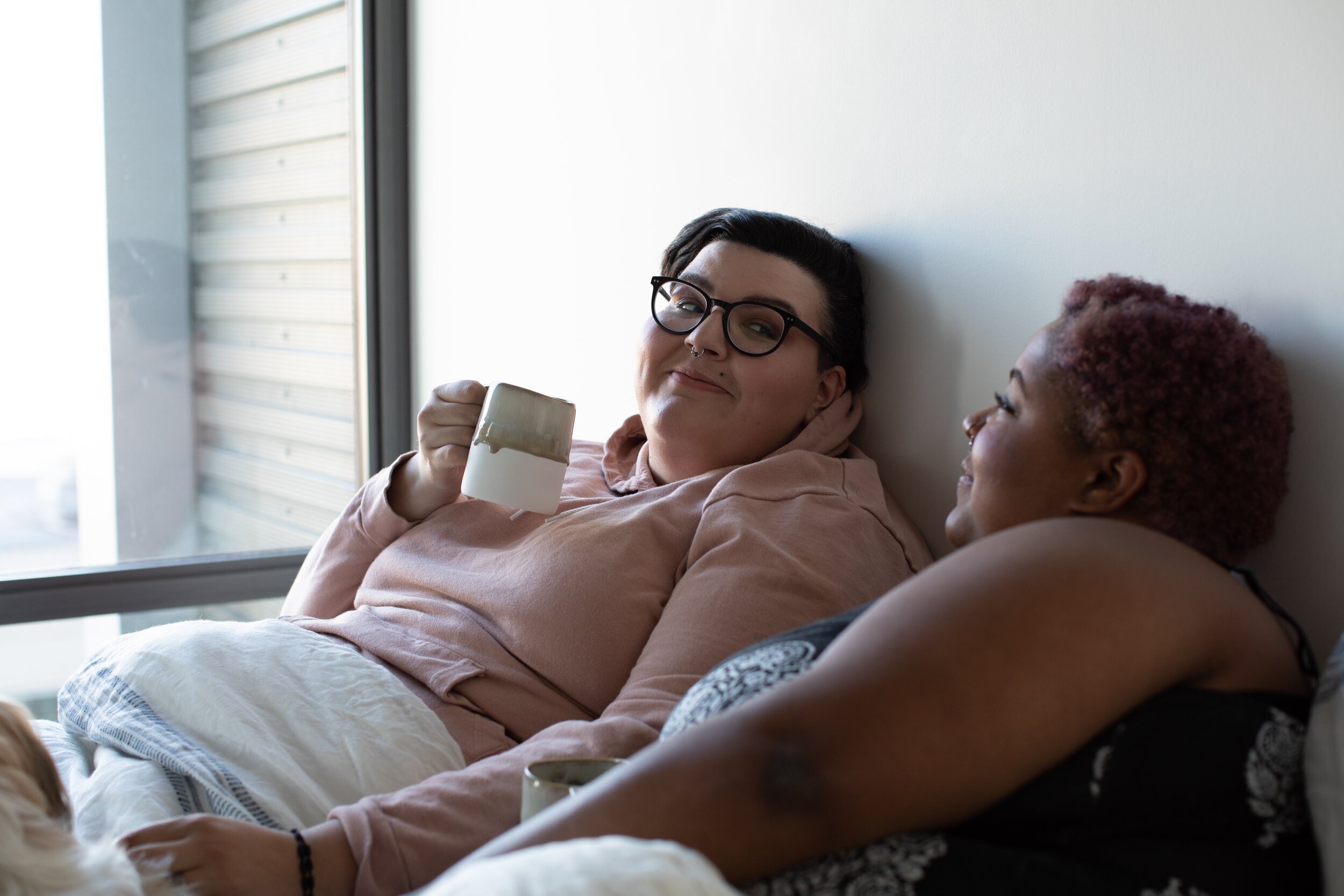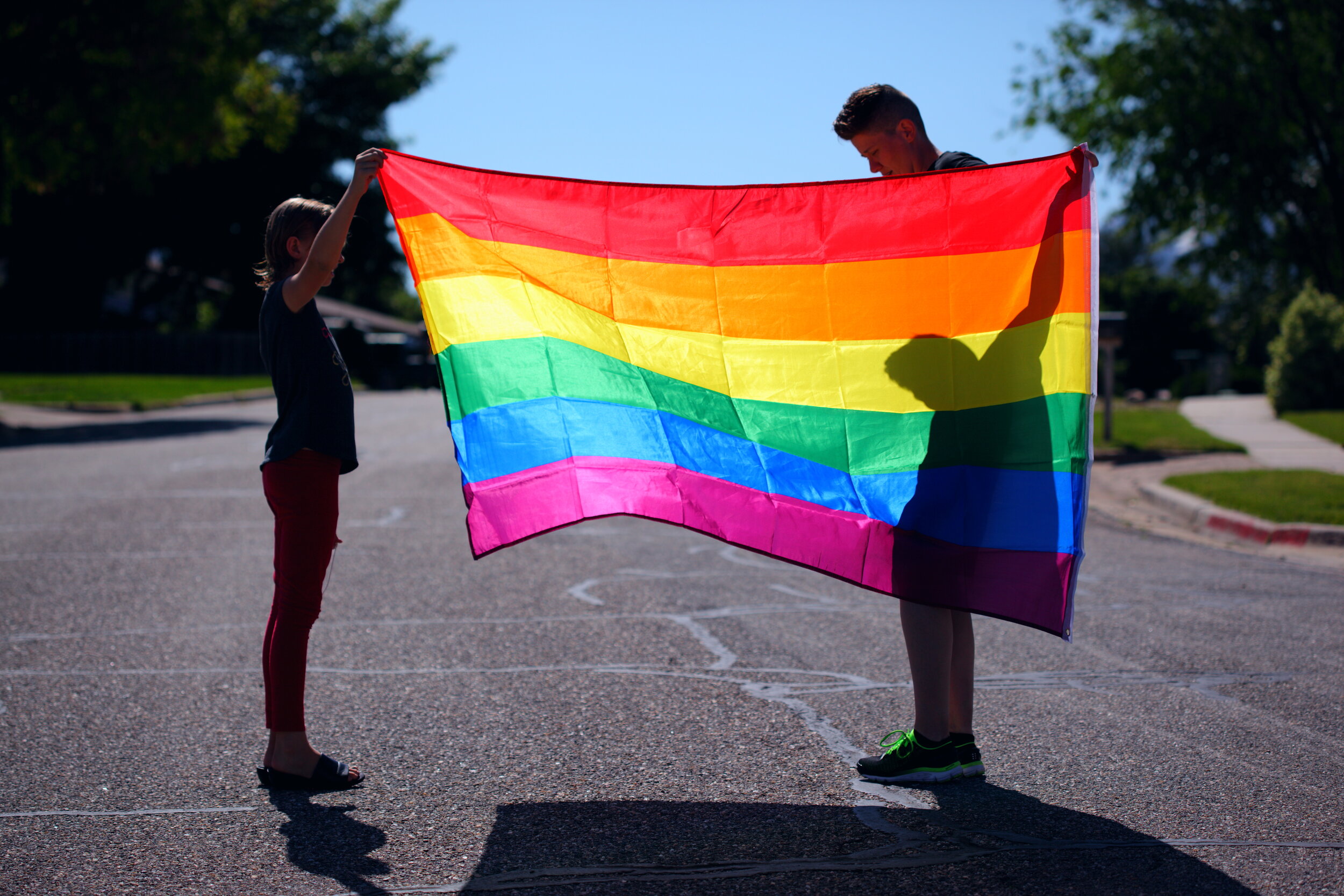Inclusive Midwifery
*Note: I initially set out to write a single blog post explaining our inclusive practice, and encouraging other midwives to consider the ways in which they might make their own practices more inclusive. However, I had multiple people reach out to me offering stories about their challenges in receiving LGBTQ+ competent healthcare, and it quickly became clear that this post was turning into a series. So, more stories and information will come…Stay tuned!
Midwife Jessi here! A few years ago my sibling came out as non-binary/gender non-conforming and pansexual. For them, this means that they don’t fit within the traditional cultural definition of what it means to be a woman or a man, and that they identify with both (and at times neither) gender identities. Obviously, traditional pronouns such as “he/she” do not accurately describe who they are, and the pronouns “they/them'“ work much more accurately to describe the spectrum on which they fall, encompassing all parts of themselves including traditionally masculine, feminine, and queer parts of their personality and self expression.
Around the same time, a series of events happened in our family and friends group, including many of us coming out as bisexual, or gender non-conforming/non-binary, queer etc. This was a big shift for many of us, as we were raised in environments that didn’t really give us the option of being anything other than heterosexual with defined and set gender roles for those born a “girl” or a “boy.” Unlearning the falsehood that people are black and white or easily typed was (and remains) a process.
I was lucky enough to score a preceptorship with Mosaic Midwifery as I was training to be a midwife. This practice places heavy emphasis on providing inclusive healthcare services to LGBTQ+ families and trains their students to be competent in inclusive language and midwifery care for all family types.
This preceptorship, together with a deep love and new understanding of LGBTQ+ population needs, helped create in me an ethic for actively continuing to gain competency training and providing services which reflect the needs of all family types - not just the ones typically represented in homebirth photos (which happen to often be white, heterosexual, middle-class families).
It should be clear that the people choosing to have babies are not always accurately described by the gender and sexual orientation assumptions that some midwives hold.
Midwives serve all family types, and this means that we need to understand the unique health and social issues of a variety of populations. I would argue this is especially true of marginalized demographics in our society, of which LGBTQ+ families have historically been.
Today, I am really excited to finally be able to offer midwifery services in my own practice, and Midwife Meredith and I both feel strongly about keeping Wilder Midwifery actively inclusive and competent in LGBTQ+ healthcare services and the needs of these specific populations.
Our position of inclusivity brings up a lot of questions from some people, most often from members of the midwifery community. So, I thought I would address some of these questions as best I can, and present one example of what an inclusive healthcare practice can look like.
But first, we need to back up and address some basic definitions:
Helpful Definitions and Background:
Often, the terms sex, sexuality, sexual orientation, and gender are lumped together and create a lot of confusion for people. Add to this the variety in relationship types and you have a situation rife for stereotyping and misunderstanding. So, let’s clarify a few things first:
Sex: this is something we are assigned at birth based on our genitals and (sometimes) our chromosomes.
Penis = Male.
Vulva = Female.
Combination/variation = Intersex.
Sexual Orientation: this describes who we are sexually attracted to, and often (though not always) describes the types of people we wish to partner with.
Homosexual* = attracted to those of the same sex. NOTE that this term is not being used very often anymore, due to it’s widespread use in a derogatory manner. Nowadays, it is better to use the terms “gay” or “lesbian” to denote someone attracted to the same sex, as these terms carry less of a derogatory history and connotation.
Heterosexual = attracted to those of the “opposite” sex.
Bi-sexual = attracted to “both” sexes (generally referring to males and females).
Pan-sexual = attracted to those of all sexes and genders (this can include intersex, gender nonconforming and trans people).
Asexual = not sexually attracted to any sex or gender.
Demi-sexual = generally not sexually attracted to people, but occasionally attracted in some specific situations (such as only after a strong romantic bond has been formed).
There are a few other identities not listed here, but these are arguably the main/most common ones. To learn more about sexuality and definitions you can see this fun slide show.
Gender: this describes your self expression and the assigned roles and expectations placed on you by others, and often in our culture is assigned at birth based on your sex.
For example, you have a vulva and are assigned the sex “female” at birth. In our culture this means you are therefore also a “girl” (accompanied with a set of gender norms, which at their most extreme include pink princesses and calm quiet behavior).
However, just because you have a vulva does not automatically mean you will identify with the culturally created definition of what it means to be a “girl.” This is gender. Many people are realizing that these definitions simply do not match, or are too restrictive, to define who they actually are at heart. This means that you can identify as a different gender, but may still have genitals which assign to you a specific sex.
Cis-gender = someone who feels their gender identity is consistent with that traditionally assigned to their sex at birth.
Genderqueer/Non-binary/Gender-Noncomforming = someone who does not fully identify with the gender traditionally assigned to them at birth. They may identify as a combination of “both” genders, neither, or a specific combination of portions of traditional gender. There is some nuance between these terms, but I think this broad definition covers the bulk of explaining this category of gender identity.
Transgender = Someone who identifies as a different gender identity than what they were assigned at birth based on sex. This term includes both those who transition to the “opposite” gender, and those who transition to a different gender identity (such as non-binary). Some trans people express their true gender identity externally without transitioning their sex (via hormonal therapy or surgery etc), while others also transition their sex to fully experience and encompass their true gender identity.
Gender is perhaps one of the more complicated of these definitions for people to understand, and it encompasses a lot of how we move in the world and how we are perceived by other people. For more information on this you can check out this website.
To help clarify the differences between these definitions see this adorable image to help you conceptualize them (thank you to Michelle Gilley, CPM who first shared this with me).
Relationship and Romantic Configurations: these describe the types of relational configurations you desire, seek out, or are engaged in.
There are arguably as many of these as there are people. We are complex, and the more we interact with each other the more complicated it can become. However, here are some useful terms to be aware of (which by no means exclude other relational configurations):
Monogamous = exclusive relationship between two people. This relationship may or may not be sexual, and is not defined by your sex or gender type.
Non-monogamous/open relationships = non-exclusive relationship. This term includes many different types of relationships, but essentially means that you are not engaged exclusively in sexual activity or romance with your “designated” partner. This relationship type is generally consensual, all though there are situations in which the relationship is non-monogamous and only one partner is aware of this (colloquially called cheating).
Polyamorous = the open engagement in multiple sexual and/or romantic relationships simultaneously. There may or may not be one “designated” partner, and the person may in fact have several committed partners who are aware of one another, and who may or may not be equally committed to each other.
What does it mean to be an LGBTQ+ inclusive midwife?
In the broadest sense, it means that our practice is not based around the assumption that our clients are in traditional relationships, or that they identify with traditional gender identities or sexual orientations.
We know that folks can engage in childbearing and child-rearing without ascribing to these categories - and that it is important for their healthcare (including midwifery!) to be individualized to the needs of their family and their bodies.
Beyond this, we recognize that it can actually be quite damaging and isolating to receive healthcare in a setting that doesn’t recognize or understand your identity. LGBTQ+ families face this sort of isolation (and passive or active discrimination) on a daily basis, and the last place they should have to experience it is in the office of their midwife.
It’s not enough to say “I would serve these clients if they came to me.” The truth is that unless practitioners are taking steps to actively educate themselves about these populations and make them feel welcome and at home in their clinics, then these populations will not be adequately served by the care you can provide.
For example, if your medical history forms still have categories which list terms like “Mother” and “Father,” or only leave the option for selecting “Male” or “Female” when choosing sex, or do not have a space which identifies gender or pronoun usage - then your practice is engaging in exclusionary behavior. LGBTQ+ families frequently not only don’t fit within these categories, but this can re-enforce a sense of “otherness” and disconnect from their care provider - who apparently doesn’t recognize their unique identity and needs.
Beyond this, if you are not educated in supporting the needs of clients who have used hormone replacement therapy, utilized the services of a sperm donor, who have multiple committed partners etc, then your care is likely exclusionary by default.
The heart of midwifery is providing our clients with individualized care. And to accomplish this, we are obliged to seek education and training to care for the clients we may serve - and it isn’t just heterosexual cis-gendered people who become pregnant.
Some recommendations for more inclusive midwifery practice:
Edit your practice forms (medical history, prenatal records, birth certificate worksheet etc) to reflect gender identity options (and pronouns!), sexuality options, and relationship configurations. This can be as simple as a comment box that asks “What pronouns do you use?” or “How do you describe your gender identity?”
Get competency training and education on serving these populations! Really, this probably should be #1, as you need to have a solid understanding of how to adjust your care to make sure you are addressing the health and social needs of LGBTQ+ populations before reflecting a front of inclusivity (IMO). There are some amazing options for healthcare providers and birth workers available! Here are a few:
Maia Midwifery & Fertility Training: runs recurring courses on servings trans and genderqueer populations and LGBTQ+ families.
Cornerstone Doula Trainings: Offers a class supporting trans, and gender non conforming clients led by Tristan Reese (I’ll be at this in November! Join me there).
OHSU school of Medicine in Portland: Offers various classes on LGBTQ+ inclusivity and health. There is an upcoming class on trans health in about a week that would be great to get in on (I would be here too, but am going to be out of town).
Birth is for Every Body: TONS of amazing continuing education resources available on this list. Many are free and freaking awesome!
Adjust your advertising and your imagery to reflect more diverse demographics. Let these families know they are welcome and a part of the clientele you serve. Include lesbians, genderqueer, or trans individuals in your website or social media imagery (with their permission). Representation matters!
Be diligent about your language, police your internal biases, and apologize for your mistakes. Come on, be an adult. Be sensitive to how your assumptions might hurt somebody (even accidentally) and make it right when you mess up. I am by no means perfect at this, and mess up ALL THE TIME. What matters is that you commit yourself to being inclusive, and keep adjusting and growing as you learn how to do this better and better.
Ask questions, and keep learning. Don’t assume that just because you took one class means you now know everything. Stay humble, and ask questions of each client that comes into your care. “How do YOU identify?” “How can I serve YOU?” “What needs do YOU have?”
Birth workers, we can do better! Creating a midwifery community that focuses on inclusivity it important. What ways do you foster inclusivity in your own practices?






